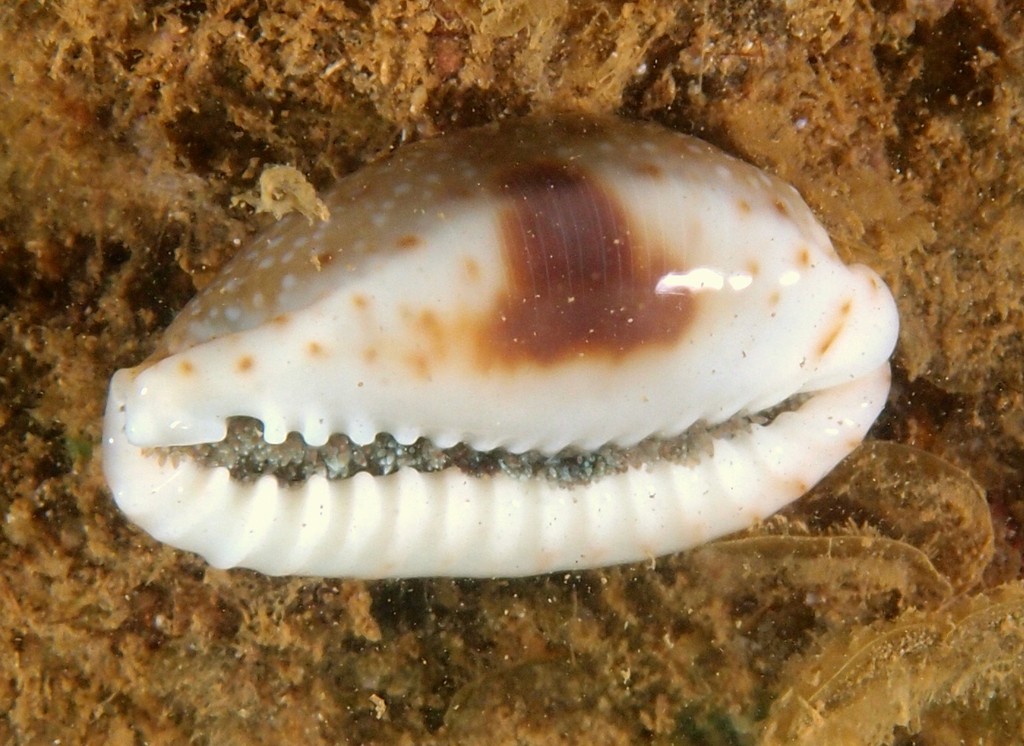EROSARIA EROSA - (LINNAEUS, 1758)
Mollusca (Phylum) > Gastropoda (Class) > Caenogastropoda (Subclass) > Littorinimorpha (Order) > Cypraeoidea (Superfamily) > Cypraeidae (Family) > Erosaria (Genus)
Eroded cowrie, Gnawed cowry, porcelaine érodée,
Description
Le dos est gris rosé à jaune ocre avec des zones brunes, il porte des taches rondes blanches et quelques taches foncées proches de la base. La base est blanche à beige clair, parcourue de stries verticales chocolat. Une tache foncée à peu près rectangulaire marque chaque côté. Les tentacules sont nombreux et hérissés de cônes. Taille adulte 3cm - 5cm. Profondeur 0 - 10m.
Biologie
La porcelaine érodée vit cachée sous les roches le jour, avec le manteau le plus souvent retiré dans la coquille. Le manteaumanteau : partie du corps des mollusques qui sécrète la coquille ou dessus du corps des opistobranches. la recouvre la nuit pour la camoufler. Elle se nourrit d'algues qu'elle décroche grâce à sa langue râpeuse, mais aussi d'invertébrés et de débris animaux.
Distribution
Océan Indien et Pacifique tropical. Présent en Nouvelle-Calédonie.
Synonymes
Cypraea erosa (Linnaeus, 1758)
Erosaria sinensis (Ma, 1997)
Sous-espèces
Erosaria erosa chlorizans (Melvill, 1888)
Erosaria erosa erosa (Linnaeus, 1758)
Erosaria erosa fuscocincta (Bozzetti, 2008)
-------------------------------
Erosaria erosa, common name the gnawed or eroded cowry, is a species of sea snail, a cowry, a marine gastropod mollusk in the family Cypraeidae, the cowries.
Description
The shell of these quite common cowries reaches on average 32–38 millimetres (1.3–1.5 in) in length, with a maximum size of 75 millimetres (3.0 in) and a minimum adult size of 15 millimetres (0.59 in). The dorsum is yellow-ocher or pale brown, with many small white spots. The extremities of the shell show dark brown spots. A dark brown area which is roughly rectangular is present on each side close to the edge. The base is white to light beige, with thin transverse stripes. At night in the living cowries, the extremely papillose brownish mantle usually covers the shell completely, camouflaging the animal.
Distribution
This species and its subspecies occur in the Indian Ocean along the coasts of Aldabra, Chagos, the Comores, the East Coast of South Africa, Kenya, Madagascar, the Mascarene Basin, Mauritius, Mozambique, Réunion, the Seychelles, Somalia and Tanzania, as well in the Western Pacific Ocean (Malaysia, Australia, Philippines, Polynesia and Hawaii). Reported from New Caledonia.
Biology
These cowries live in warm tropical waters, on shallow intertidal reefs or in lagoons at about 2–10 metres (6 ft 7 in–32 ft 10 in) of depth. Like most other cowries, during the day they usually hide under rocks slabs with the mantle drawn into the shell. They feed only at dawn or dusk.
Eroded cowrie, Gnawed cowry, porcelaine érodée,
Description
Le dos est gris rosé à jaune ocre avec des zones brunes, il porte des taches rondes blanches et quelques taches foncées proches de la base. La base est blanche à beige clair, parcourue de stries verticales chocolat. Une tache foncée à peu près rectangulaire marque chaque côté. Les tentacules sont nombreux et hérissés de cônes. Taille adulte 3cm - 5cm. Profondeur 0 - 10m.
Biologie
La porcelaine érodée vit cachée sous les roches le jour, avec le manteau le plus souvent retiré dans la coquille. Le manteaumanteau : partie du corps des mollusques qui sécrète la coquille ou dessus du corps des opistobranches. la recouvre la nuit pour la camoufler. Elle se nourrit d'algues qu'elle décroche grâce à sa langue râpeuse, mais aussi d'invertébrés et de débris animaux.
Distribution
Océan Indien et Pacifique tropical. Présent en Nouvelle-Calédonie.
Synonymes
Cypraea erosa (Linnaeus, 1758)
Erosaria sinensis (Ma, 1997)
Sous-espèces
Erosaria erosa chlorizans (Melvill, 1888)
Erosaria erosa erosa (Linnaeus, 1758)
Erosaria erosa fuscocincta (Bozzetti, 2008)
-------------------------------
Erosaria erosa, common name the gnawed or eroded cowry, is a species of sea snail, a cowry, a marine gastropod mollusk in the family Cypraeidae, the cowries.
Description
The shell of these quite common cowries reaches on average 32–38 millimetres (1.3–1.5 in) in length, with a maximum size of 75 millimetres (3.0 in) and a minimum adult size of 15 millimetres (0.59 in). The dorsum is yellow-ocher or pale brown, with many small white spots. The extremities of the shell show dark brown spots. A dark brown area which is roughly rectangular is present on each side close to the edge. The base is white to light beige, with thin transverse stripes. At night in the living cowries, the extremely papillose brownish mantle usually covers the shell completely, camouflaging the animal.
Distribution
This species and its subspecies occur in the Indian Ocean along the coasts of Aldabra, Chagos, the Comores, the East Coast of South Africa, Kenya, Madagascar, the Mascarene Basin, Mauritius, Mozambique, Réunion, the Seychelles, Somalia and Tanzania, as well in the Western Pacific Ocean (Malaysia, Australia, Philippines, Polynesia and Hawaii). Reported from New Caledonia.
Biology
These cowries live in warm tropical waters, on shallow intertidal reefs or in lagoons at about 2–10 metres (6 ft 7 in–32 ft 10 in) of depth. Like most other cowries, during the day they usually hide under rocks slabs with the mantle drawn into the shell. They feed only at dawn or dusk.
